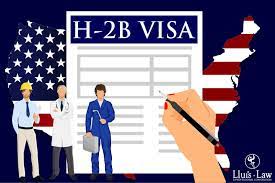There are different kinds of visas that let foreign nationals work in the U.S. for a selected amount of your time. U.S. Temporary Non-Agricultural (H-2B) Visas are on the market for foreign workers in non-agricultural fields to work within the U.S., only if there’s a meagerly amount of domestic laborers to fill a position.
Employing workers beneath an H-2B visa should not have an effect on wages or working conditions for U.S. employees within the same field.
U.S. Temporary Non-Agricultural (H-2B) Visas
H-2B visas are typically used for jobs that are temporary however not agricultural – for instance, jobs at ski mountains, beach resorts, or amusement parks. For agricultural positions, an H-2A visa is needed.
Individuals cannot apply for a visa. An Employer or employer’s agent should apply for a visa on behalf of the person they need to employ. The petitioning employer should demonstrate that it’s a seasonal want for added workers, or that it should add employees briefly thanks to accumulated demand.
Temporary workers cannot become regular employees, nor will they replace full-time or permanent employees.
Generally, H-2B visas are valid for one year but are often extended incrementally supported on annual periods, with a maximum of 3 years. Previous time spent in the U.S. beneath different H- or L-type visas additionally counts toward the full closing date.
However, employees might typically recapture time spent outside the U.S. throughout a licensed stay.
Also read about How to Apply for a Green Card in the U.S.
H-2B Requirements
In order to get an H-2B visa, an employer should guarantee that:
- The specific job they’re trying to fill is temporary in nature, albeit the kind of labor itself isn’t temporary. The petitioner should prove that the work may be a one-time, short-run prevalence, a seasonal want tied to an annual event, season, or pattern, peak time for temporary workers throughout a busy season, or intermittent want.
- The usage of H-2B staff won’t have a negative impact on the working conditions, together with the wages, of domestic workers used in similar fields.
- There aren’t a decent variety of domestic employees to use or that are willing and ready to complete the temporary work.
- The company is suitably certified by the U.S. Department of Labor.
Note: The countries eligible for H-2B visas is updated yearly by the Department of Homeland Security and also the Department of State.
The updates for H-2B visas are valid one year from publication
.Also read about How to Apply for a U.S. Work Permit
How to Apply for an H-2B Visa
Applying for an H-2B visa is a three-step process:
- The sponsoring employer should first submit the mandatory temporary labor certification to the Department of Labor (U.S. or Guam, reckoning on their location).
- After receiving a short lived labor certification from the DOL, the employer will then submit an I-129 form to U.S. Citizenship and Immigration Services (USCIS).
- After USCIS approves form I-129, prospective employees might apply for a visa and admission. Generally, this suggests applying for an H-2B visa at a U.S. embassy or consulate then seeking admission at a port of entry, via U.S. Customs and Border Protection. If a visa isn’t needed, employees are often admitted directly by U.S. Customs.
H-2B Cap
There is a statutory limitation, or a “cap,” placed on the amount of employees allowed to enter the country with H-2B visas per fiscal year. In every fiscal year, 66,000 H-2B cap visas are issued, but 33,000 of them should begin employment within the half of the year and also the different 33,000 within the last half.
Also read about Common Visa Scams (For U.S. Migrators)
H-2B Cap Exemptions
Any employees who have otherwise been counted toward the cap within the same fiscal year are exempt from the cap limit. Also, any current H-2B worker either seeing a change of employer or an extension of stay also are exempt.
Any employees hired in the Commonwealth of the Northern Mariana Islands and/or Guam also are exempt from the cap till December 2029. Additionally, fish roe processors, fish roe technicians or supervisors of fish roe process are exempt from the cap.
Note: Dependents of H-2B visa holders receive H-4 non-immigrant dependent visas beneath their beneficiary.
The information contained in this article isn’t legal recommendation and isn’t a substitute for such recommendation. State and federal laws change oftentimes, and also the information in this article might not replicate your own state’s laws or the foremost recent changes to the law.

